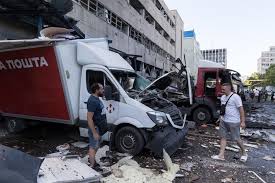
The war in Ukraine, now stretching past 18 months, has entered a tense phase. The initial blitzkrieg by Russia has morphed into a grinding conflict, with fighting concentrated in the eastern Donbas region. While significant territorial gains haven’t been made on either side recently, several key developments are shaping the course of the war.
Military Stalemate and Shifting Strategies
The Donbas offensive has become a war of attrition. Russia throws wave after wave of troops and firepower at Ukrainian positions, seeking incremental advances. Ukrainian forces, bolstered by Western military aid, have put up a fierce resistance, inflicting heavy casualties on the attackers.
Drone Warfare and Evolving Tactics: Both sides are increasingly relying on drones for reconnaissance, surveillance, and attacks. Ukrainian drone strikes have targeted Russian supply lines and command centers, disrupting their offensives. Russia, facing significant manpower shortages, is reportedly recruiting mercenaries and deploying outdated Soviet-era tanks.
Global Food Crisis: The war has severely disrupted Ukraine’s agricultural sector, a major global exporter of wheat and corn. This disruption, coupled with sanctions on Russia, has triggered a global food crisis, with rising food prices threatening vulnerable populations, particularly in Africa and the Middle East.
The Looming Threat of Winter: As winter approaches, concerns are mounting about the impact on the war. Harsh weather conditions could further slow down military operations, but it could also give Russia a potential advantage if Ukrainian energy infrastructure is further damaged. European nations are scrambling to secure alternative energy sources to avoid energy shortages during the winter months.
The Humanitarian Crisis Persists: Millions of Ukrainians remain displaced internally or have fled the country as refugees. The war has caused widespread damage to civilian infrastructure, leaving many without access to basic necessities like food, water, and shelter. Humanitarian organizations are struggling to meet the growing needs of the displaced population.
The Diplomatic Stalemate and Potential Shift:
Peace talks have stalled, with both sides seemingly unwilling to compromise. However, recent developments suggest a potential shift in diplomatic efforts.
The Role of International Actors: The United States and its allies continue to provide significant military and financial aid to Ukraine. However, there are growing concerns about “war fatigue” and the long-term sustainability of this support. Additionally, some European nations are pushing for a negotiated settlement, fearing a prolonged war will destabilize the entire region.
Turkey’s Role as Mediator: Turkey has emerged as a potential mediator between Russia and Ukraine. Turkish President Erdogan has fostered dialogue with both sides and facilitated the exchange of prisoners of war. While the success of these efforts remains uncertain, Turkey’s role could be crucial in breaking the diplomatic deadlock.
The Information War and Media Manipulation:
The war in Ukraine is not just fought on the battlefield but also in the information sphere. Both sides are engaged in aggressive propaganda campaigns, aiming to shape the narrative and control public opinion. Independent and reliable news sources are crucial for discerning fact from fiction.
The Long Road to Recovery:
Even if a ceasefire is achieved, the road to recovery for Ukraine will be long and arduous. Rebuilding the country’s infrastructure, reviving the economy, and addressing the long-term psychological trauma inflicted by the war will be monumental tasks. The international community will need to remain committed to providing long-term support for Ukraine.
Uncertainties and Potential Scenarios:
The future of the war remains uncertain. Several potential scenarios could unfold:
-
Stalemate and Protracted Conflict:
The current stalemate could continue for an extended period, with neither side able to achieve a decisive victory. This scenario would have devastating consequences for Ukraine and further destabilize the region. -
Escalation and Wider Conflict:
An escalation of the conflict, such as a direct confrontation between Russia and NATO, cannot be entirely ruled out. This scenario would have catastrophic consequences for Europe and potentially the entire world. -
Negotiated Settlement: A negotiated settlement, likely involving significant territorial concessions by Ukraine, remains a possibility. However, the level of trust between the two sides makes achieving a sustainable agreement difficult.
Conclusion:
The war in Ukraine has entered a critical phase. While the immediate future remains uncertain, the decisions made in the coming months will shape the course of the conflict and its long-term consequences. The international community must continue to support Ukraine in its struggle for self-determination and hold Russia accountable for its actions. Addressing the global food crisis and preparing for the upcoming winter are also pressing issues.
This article provides a brief overview of some of the key developments in the war in Ukraine. It is important to stay informed by following reputable news sources and critical analyses to gain a deeper understanding of this complex conflict.









